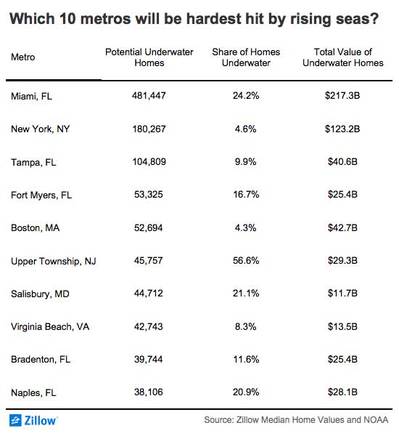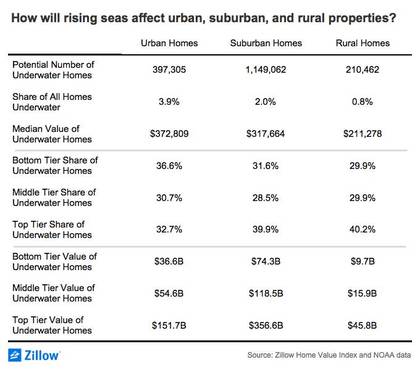The WPJ
THE WORLD PROPERTY JOURNALReal Estate Facts Not Fiction
Residential Real Estate News

Almost $1 Trillion of American Homes at Risk From Rising Seas This Century
Residential News » Miami Edition | By Michael Gerrity | October 19, 2017 9:00 AM ET
Miami has most risk exposure in U.S., followed by New York City
According to new research by Zillow, rising sea levels are expected to impact $916 billion worth of U.S homes in the next 100 years, most of which are low-end or median-value homes.
 The majority of all homes at risk of flooding due to rising sea levels are in suburban areas - 65.4 percent of homes are in suburban areas, compared to 22.6 percent in urban locations and 12 percent in rural areas.
The majority of all homes at risk of flooding due to rising sea levels are in suburban areas - 65.4 percent of homes are in suburban areas, compared to 22.6 percent in urban locations and 12 percent in rural areas.Overall, 39 percent of the homes expected to be underwater in 2100 are among the nation's most valuable. The rest are near the median value or below - and a quarter are among the least valuable homes. This is significant because less wealthy communities and households are less likely to be able to afford preventative measures to ward off rising seas. For most homeowners, a home is their biggest single investment, and its value is a major share of their overall wealth. Any significant damage to a home is harder to recover from when most of an owner's wealth is tied up in that same home.
 Owners of high-end homes are more likely to live in communities with the resources and connections needed to protect their homes, such as building sea walls or making structural changes that help homes withstand floodwaters. But in markets where the majority of homes at risk of rising water are among the least valuable in the area, these options might be out of reach.
Owners of high-end homes are more likely to live in communities with the resources and connections needed to protect their homes, such as building sea walls or making structural changes that help homes withstand floodwaters. But in markets where the majority of homes at risk of rising water are among the least valuable in the area, these options might be out of reach.Less than 20 percent of homes in Honolulu that are at risk of flooding due to rising sea levels are high-end homes. That means the majority of homeowners who could lose their homes may be less able to make investments to protect their properties, especially lower income homeowners who have to spend a larger share of their income on mortgage payments.
"We've seen the enormous impact flooding can have on a city and its residents," said Zillow Chief Economist Dr. Svenja Gudell. "It's harder for us to think about it on a long-term timeline, but the real risks that come with rising sea levels should not be ignored until it's too late to address them. With organized and committed planning, cities can help protect both current and future residents. Living near the water is incredibly appealing for people around the country, but it also comes with additional considerations for buyers and homeowners. Homes in low-lying areas are also more susceptible to storm flooding and these risks could be realized on a much shorter timeline as we have seen time and time again."
Miami holds 25.8 percent of all U.S. homes at risk of rising sea levels, which are cumulatively worth $217.3 billion. The three cities with the greatest number of homes threatened by higher sea levels are in the Miami metropolitan area. Fort Lauderdale, Miami Beach and Miami could all lose more than 30,000 homes to sea level increases.
Zillow analyzed the types of homes that could be underwater, absent preventative measures, based on recent estimates of how high sea levels could rise by 2100 due to climate change.
Sign Up Free | The WPJ Weekly Newsletter
Relevant real estate news.
Actionable market intelligence.
Right to your inbox every week.
Real Estate Listings Showcase
Related News Stories
Residential Real Estate Headlines
- More Americans Opting for Renting Over Homeownership in 2024
- BLOCKTITLE Global Property Tokenization Platform Announced
- Small Investors Quietly Reshaping the U.S. Housing Market in Late 2024
- Greater Miami Overall Residential Sales Dip 9 Percent in November
- U.S. Home Sales Enjoy Largest Annual Increase in 3 Years Post Presidential Election
- U.S. Housing Industry Reacts to the Federal Reserve's Late 2024 Rate Cut
- U.S. Home Builders Express Optimism for 2025
- Older Americans More Likely to Buy Disaster-Prone Homes
- NAR's 10 Top U.S. Housing Markets for 2025 Revealed
- U.S. Mortgage Delinquencies Continue to Rise in September
- U.S. Mortgage Rates Tick Down in Early December
- Post Trump Election, U.S. Homebuyer Sentiment Hits 3-Year High in November
- Global Listings Aims to Become the Future 'Amazon of Real Estate' Shopping Platform
- Greater Las Vegas Home Sales Jump 15 Percent in November
- Ultra Luxury Home Sales Globally Experience Slowdown in Q3
- World Property Exchange Announces Development Plan
- Hong Kong Housing Market to Reach Equilibrium in Late 2025
- Construction Job Openings in U.S. Down 40 Percent Annually in October
- U.S. Mortgage Applications Increase in Late October
- World Property Markets, World Property Media to Commence Industry Joint-Venture Funding Rounds in 2025
- New Home Sales Hit 2 Year Low in America
- U.S. Pending Home Sales Increase for Third Consecutive Month in October
- Pandemic-led Residential Rent Boom is Now Fizzling in the U.S.
- Emerging Global Real Estate Streamer WPC TV Expands Video Programming Lineup
- 1 in 5 Renters in America Entire Paycheck Used to Pay Monthly Rent in 2024
- U.S. Home Sales Jump 3.4 Percent in October
- Home Buyers Negotiation Power Grows Amid Cooling U.S. Market
- Canadian Home Sales Surge in October, Reaching a Two-Year High
- Greater Orlando Area Home Sales Continue to Slide in October
- U.S. Mortgage Credit Availability Increased in October
- U.S. Mortgage Rates Remain Stubbornly High Post Election, Rate Cuts
- Construction Input Prices Continue to Rise in October
- BETTER MLS: A New Agent and Broker Owned National Listings Platform Announced
- Home Prices Rise in 87 Percent of U.S. Metros in Q3
- Caribbean Islands Enjoying a New Era of Luxury Property Developments
- The World's First 'Global Listings Service' Announced
- Agent Commission Rates Continue to Slip Post NAR Settlement
- Market Share of First Time Home Buyers Hit Historic Low in U.S.
- Greater Palm Beach Area Residential Sales Drop 20 Percent Annually in September
- Mortgage Applications in U.S. Dip in Late October
Reader Poll
Marketplace Links
This website uses cookies to improve user experience. By using our website you consent in accordance with our Cookie Policy. Read More





